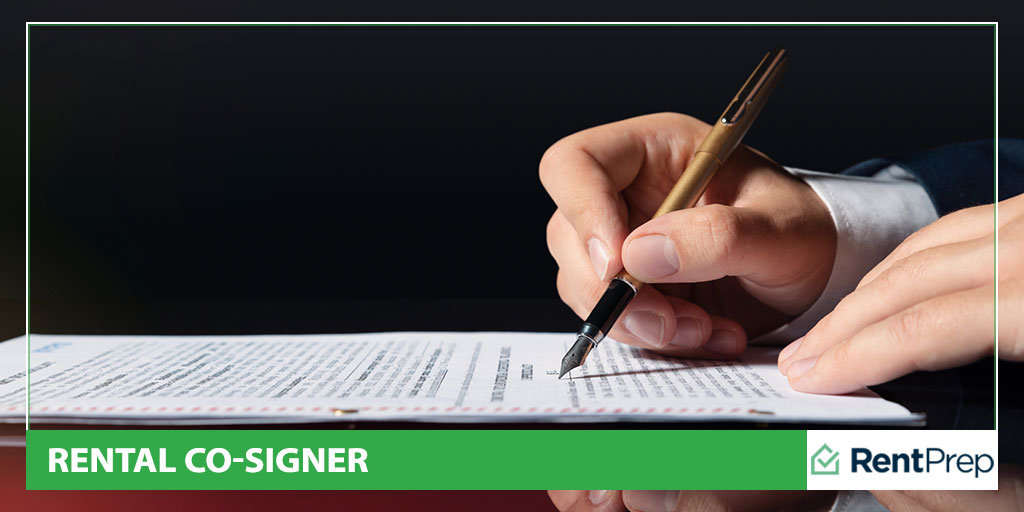
Working with tenants requiring or requesting a rental cosigner is not uncommon in most locations. Many landlords say it’s more common than not to work with multiple individuals on a lease and sometimes use a cosigner lease agreement.
Do you understand why and when to bring in a cosigner on leases? Cosigners can be a great way to ensure that your property will be intact when returned to you, but it’s not always the right choice. Sometimes, cosigning can lead to just as much hassle as continuing the search for a tenant who’s a better fit.
Understanding what a cosigner is, how to lease with a cosigner, and what the cosigner is responsible for is essential for success as a landlord. Keep reading to learn more about this specialty lease type and situation.
Table Of Contents On Cosigners For Leases
Cosigners are necessary for some lease agreements, particularly when an individual is a new or newly reformed renter. Work through the necessary steps with us to setting up an appropriate lease cosigner addendum today:
- What Is A Rental Cosigner?
- Pros And Cons Of Cosigners
- FAQs About Cosigners On Leases
- Setting Up Cosigners For Rent Agreements
What Is A Rental Cosigner?

A rental cosigner is an individual that agrees to be responsible for covering rental payments if the tenant misses them. The cosigner is part of the lease agreement when signed with you at the start of a lease period. When landlords are worried about being able to collect rent on time, they may request a cosigner before agreeing to begin a tenancy.
Typically, a cosigner is not someone living at the rental unit, but there may be situations where this is true. Cosigners are often parents, siblings, or even a third party hired to provide this support.
Legally, the cosigner is responsible for everything the tenant is responsible for. Penalties and fees related to how the tenant uses the property could be passed on to the cosigner if the tenant falls through, so it’s important for cosigners to be thoroughly informed about what they are committing to.
Who Can Be A Cosigner?
While cosigners are typically family members or friends of the leasee, they can also be third-party guarantors hired to provide this service. The individual should have a strong financial background and credit and a high enough income to support the tenant if they fall behind on rent. Landlords may prefer that the consigner makes as much as 80 times the monthly rent.
A cosigner must agree to share personal financial information with the landlord, just as potential tenants do. You will likely screen the cosigner, so they must also agree to that. If a cosigner is uncomfortable with providing more than their word, you’d be in the right to move on.
State Laws
Before proceeding with any type of cosigner lease, make sure that you look up your state and local laws. There are state specifics on lease and cosigner agreements. These rules may influence who can be a cosigner, what can be included in a lease agreement, and other details that will influence how you move forward.
Pros And Cons Of Cosigners

Why exactly would you or your potential tenants be interested in cosigners? This process involves another individual in the rental process, so it can seem unappealing at face value. As with all rental decisions, however, there are both pros and cons to using this method.
The Benefits
Strong Financial Backing
Renting to tenants without a strong credit history can be scary, but you may still want to give the tenant a chance. In this case, requiring a cosigner allows the tenant to secure a home while you secure your investment. Limit your financial risk while renting by using cosigners when necessary.
Expand The Tenant Pool
Another reason to consider using cosigners on rental leases as needed is to expand your rental pool and fill more vacancies.
Some individuals, such as college students, haven’t had time to build their credit history. By allowing them a cosigner, you can fill a vacancy that might otherwise go unoccupied. This doesn’t just apply to college students. Those facing unemployment or medical issues may also benefit from having a cosigner involved in their tenancy.
Avoid Deposit Caps
Some states have very limited deposit caps for security deposits. If you would prefer to raise the security deposit for those with unsteady credit, you will not be able to in those areas. Instead, you could require a cosigner as a different type of guarantee for your investment security.
Potential Problems
Other Tenant Risks
Some landlords are tempted to accept risky tenants because a cosigner is involved, but there is more to consider than just financial risk. You shouldn’t rent to a tenant with bad credit if other red flags come up during the screening process. Screening doesn’t go entirely out the window just because you’re using a cosigner.
Flaky Cosigner
Cosigners are legally responsible for rent not paid by the tenant, but that doesn’t mean you’ll be able to get them to pay it. Rather than pursuing one individual, you could find yourself trying to track down both a tenant and their cosigner. This is a risk when using cosigners.
Additional Work
Renting with cosigners will take additional work. You’ll need to screen the cosigner in addition to the tenant, and you will also need to ensure that relevant staff is educated on how cosigners work. You will also need to prepare appropriate lease agreements and addendums for cosigning situations. A cosigner for rental application will also be helpful for screening purposes.
Specific Laws
There are many specific laws about how debt collection and rent payments must occur. If you do not communicate clearly or follow the letter of the law precisely, you could find yourself not being able to claim missing funds even if you have a cosigner on the lease. Learning the breadth of these laws in your area and consulting a real estate attorney as necessary is a must.
The Secret To Cosigning Success: Screening
Using a cosigner should act as a type of insurance when renting the property, but it can only act as such if you properly vet the cosigner and the tenant.
Screening both potential tenants and cosigners is a must. Cosigners are also responsible in the same way that you consider a tenant legally responsible for rent payments. That’s why you need to ensure they are a reliable, trustworthy party that will carry out their part of the lease agreement if necessary.
Screening can be difficult, but we’ve created the tools you need to make it easier. Through our complete screening services, you can get tenant background checks, credit reports, and other necessary records to assist you as you make your decision.
Get started with tenant screening at RentPrep today to ensure you choose the right tenants and that their cosigners are a responsible support system.
FAQs About Cosigners On Leases
Here are the top questions when it comes to allowing co-signers on a lease.
What’s the difference between a cosigner and a guarantor?
Two rental terms are often used interchangeably even though they have different meanings: cosigner vs. guarantor.
Technically speaking, a cosigner is an individual who has equal rights and responsibilities as the primary tenant. Two tenants living as roommates, for example, may be cosigners on a lease. Cosigners may or may not live in the unit depending on the specific terms, but they are equally responsible for the lease agreement.
A guarantor is someone on backup to pay rent if the tenant falls through. Should the tenant prove unable to make rent, the guarantor would be held responsible for covering that payment. They do not, however, have monthly payment requirements or rights to use the property. Often, landlords need to declare a tenant in default before the guarantor needs to pay.
However, cosigner is used by many landlords and in many areas as a synonym for guarantor. The term guarantor has fallen out of favor over time, and leases often include terminology representing these individuals as cosigners rather than as guarantors. Additionally, most landlords prefer cosigner conditions over guarantor conditions to ensure faster payment.
Unless local laws dictate that the words be used in one way or another, it’s OK to use either. The key point is that the lease agreement and any applicable addendums clearly outline the terms of the agreement, who is responsible for payment, and what will happen if either party doesn’t pay. Whether the cosigner is living at the unit or not, these terms must be included.
Do I need to include the cosigner in our rental lease agreement?
Yes. Cosigners should be included in all rental agreements when they are part of the equation. If you do not include them in the agreement, the legal obligation they carry will not be clear, and they might be able to escape the agreed-upon responsibility.
Adding a cosigner to your standard lease agreement isn’t difficult. Rather than writing a new lease entirely, you can simply add an addendum. This addendum should outline the cosigner’s rights and responsibilities and the process if the tenant falls behind on rent.
Make sure cosigners are fully informed about what they’re agreeing to and answer any questions they have along the way. While you won’t deal with them as directly as you would a tenant, you may need to contact them. Keeping up a good working relationship is important for this reason.
Does cosigning a lease affect the cosigner’s credit?
Cosigning a lease does not necessarily affect a cosigner’s credit. A cosigner would only see a negative change to their credit score if the tenant goes into default and the issue is registered with the credit bureau system. The cosigner is considered just as responsible for the late or missing payments because they agreed to take part as a cosigner.
It’s possible that being a cosigner could help someone’s credit score as well. This may happen only if you as the landlord decide to report regular and on-time rent payments for both individuals. This, however, is unlikely.
Generally, most cosigners do not see any type of change in their credit whenever they act as a cosigner as long as the rent payments are made promptly and no other lease issues occur.
Is a cosigner the same as a roommate?
While a cosigner can be a roommate, the two terms are not mutually exclusive. Roommates are typically included in a rental agreement as a cosigner that is equally responsible for the cost of the rental.
Most experienced landlords recommend that you require all occupants to be on the lease agreement as cosigners to ensure that you get paid no matter what, but some landlords will allow subletting agreements as long as there is a clear path to payment for them.
On the other hand, cosigners for house rentals are not necessarily individuals living at the property. Depending on the terms of the lease the cosigner can be someone acting as rent security. They are responsible for paying rent if the tenant falls behind, but they do not have the right to live at the property or take advantage of other aspects of the lease agreement.
In an ideal situation, they would never need to make a payment or even work with the landlord after signing the agreement.
Setting Up Cosigners For Rent Agreements
Cosigners are increasingly common on leases. From people living with roommates to those who need credit support to secure an apartment, landlords need to be able to work with a variety of individuals. Creating documentation before needing a cosigner lease addendum or agreement is a great way to ensure you are prepared for any situation.
Get the following documentation in order now so you can find success later:
- Basic lease agreement
- Lease agreement for cosigners
- Lease addendum for cosigners
- Information sheet for potential cosigners covering the process
- Cosigner application forms
By setting up these documents in advance, you’ll be able to hand them to applicable parties and start the process off smoothly. This ensures that things won’t slip through the cracks and everyone will be informed. If you use cosigners on leases, this is how to ensure you do it right and keep your profits high.

